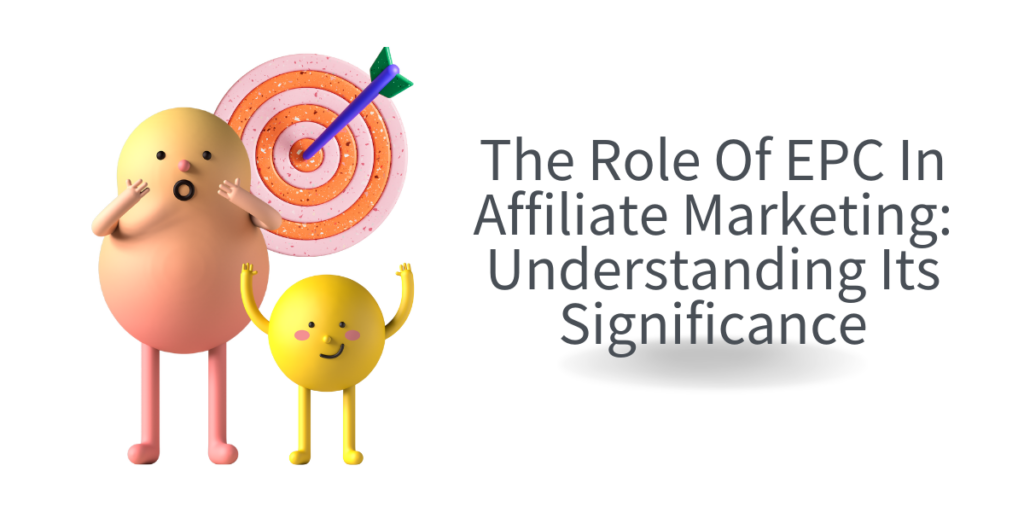What Is EPC In Affiliate Marketing?
Earnings per click (EPC) is a vital metric in affiliate marketing that measures the average revenue generated each time a user clicks on an affiliate link. EPC is commonly used in pay-per-click (PPC) campaigns, where advertisers pay affiliates based on the number of clicks their links receive.
Pay-per-click (PPC) is an internet advertising model used to drive traffic to websites, in which an advertiser pays a publisher (typically a search engine, website owner, or a network of websites) when the ad is clicked.
This content is sourced from Wikipedia: View more

Understanding your EPC is crucial for maximizing your affiliate marketing revenue and identifying which campaigns are performing well and which ones need optimization. By calculating your average earnings per click, you can gain a better understanding of your earning potential and adjust your marketing strategy accordingly.
Many affiliate marketing networks display EPC data to help affiliates evaluate and compare their earnings potential to other merchants. This information is especially useful for affiliate marketers who want to determine which products or topics to focus on and which links to share across their social media channels or email campaigns.
In conclusion, EPC is an essential metric for affiliate marketers looking to succeed in the highly competitive world of online marketing. By monitoring and optimizing their EPC, affiliates can increase their earnings potential and achieve greater success in their campaigns.
The Significance Of EPC In Affiliate Marketing
Earnings Per Click (EPC) is an important metric used by affiliate marketers to determine how much money they can earn per click. It takes into account both the commission rate and conversion rate of a particular affiliate link. By calculating the average total earnings per click, affiliates can get an idea of their earning potential.
EPC is useful in optimizing an affiliate marketer’s marketing strategy. They can determine which offers are performing well and which ones aren’t, and use this information to create more content around popular products or topics. They can also share links across their social media channels or email campaigns that have a higher EPC.
Affiliate marketers should calculate EPC over different time periods, such as 7 days or 3 months, especially when evaluating programs that may be more seasonal. The more clicks they have in their sample size, the more confident they can be in the value of their EPC. Affiliate marketers who use cost-per-click (CPC) methods to run their affiliate campaigns need to have confidence in their EPC value.
Formula To calculate Earnings per Click (EPC):
EPC = Total commissions earned by affiliate partner / number of clicks sent through affiliate links
For example, if an affiliate partner earned $1,000 in commissions and sent 100 clicks through their affiliate links, their EPC would be:
$1,000 / 100 clicks = $10 EPC
Amplifying Earnings Per Click: 7 Effective Strategies
Here are seven proven strategies to maximize your earnings per click (EPC):
- Create Scroll-Stopping Displays for Affiliate Links
Text links alone may not be enough to attract clicks. Try using eye-catching displays, such as product boxes, to promote your affiliate offers. Use tools like Hot Jar to test the effectiveness of these displays.
- Use Pop-Ups as a Last Resort to Win Clicks
Non-intrusive pop-ups can be effective in getting clicks, especially if used when a visitor is about to leave your site. Make your pop-ups more appealing by offering a deal, discount, or bonus.
- Look for Merchants with Higher Payouts
Find merchants with superior offers that pay better than Amazon or other programs with low commissions. Consider high-ticket affiliate marketing, which focuses on premium products with higher earning potential.
- Target High-Quality Traffic
Focus on quality rather than quantity when it comes to traffic. Evaluate your traffic sources and offer relevancy. Consider targeting campaigns based on countries with higher GDP.
- Test Multiple Traffic Acquisition Channels
Compare the effectiveness of various acquisition channels, such as paid ads and email marketing. Analyze your traffic sources in Google Analytics to optimize for SEO and other channels that work best for you.
- Optimize for Mobile
With more people accessing the internet on mobile devices, it’s crucial to optimize your website and affiliate links for mobile. Ensure that your affiliate links and displays are mobile-friendly to avoid losing clicks.
- Build a Targeted Email List
Email marketing remains an effective way to increase your EPC. Build a targeted email list by offering valuable content, exclusive deals, and promotions to your subscribers.
By implementing these strategies, you can amplify your EPC and increase your affiliate commissions.
Differences Between EPC, CPC And PPC
EPC, CPC, and PPC are terms commonly used in digital marketing, but they often cause confusion. To clarify, EPC stands for earnings per click and is calculated by dividing total commissions by total affiliate link clicks.
On the other hand, CPC stands for cost-per-click and refers to the amount advertisers pay each time a user clicks on their ad. This cost varies depending on the campaign, and the number of clicks ultimately determines how much is spent.
PPC, or pay-per-click, is an advertising model where advertisers pay each time their ad is clicked. For instance, Google’s AdWords is a PPC platform that allows businesses to display their ads at the top of Google’s search results.
Therefore, if a business wants to run a PPC campaign with a CPC of $5, they would pay $5 every time someone clicks on their ad. Understanding these terms is crucial for businesses looking to maximize their digital marketing efforts and increase their online presence.
Factors That Affect EPC
There are several factors that can affect EPC rates, including:
- Conversion rates: The conversion rate is the percentage of clicks that result in a sale. Higher conversion rates generally lead to higher EPC rates.
- Average order value (AOV): AOV is the average amount of money spent by a customer per order. Higher AOVs generally lead to higher EPC rates.
- Commission rates: Commission rates vary between advertisers and can have a significant impact on EPC rates. Higher commission rates generally lead to higher EPC rates.
- Traffic quality: The quality of the traffic that is directed to an advertiser’s website can also impact EPC rates. Higher quality traffic generally leads to higher EPC rates.
- Ad placement: The placement of an affiliate link on a website can also impact EPC rates. Links that are prominently placed on a website generally generate more clicks and higher EPC rates.
FAQs:
Can EPC be negative?
No, EPC cannot be negative. If there are no earnings generated from a campaign, the EPC rate would be zero.
Is EPC the same as earnings per sale (EPS)?
No, EPC (earnings per click) and EPS (earnings per sale) are different metrics.
EPC is a measure of how much money an affiliate earns per click on their affiliate link, whereas EPS is a measure of how much money an affiliate earns per sale generated through their affiliate link.
While EPC takes into account all clicks on the affiliate link, regardless of whether a sale was made, EPS only considers the revenue generated from the sales made through the affiliate link.
What is 3 month EPC in affiliate marketing?
A 3-month EPC, which stands for Earnings Per Click, is a metric commonly used in affiliate marketing to measure the average affiliate earnings per 100 clicks within a merchant’s program. It provides valuable insights into the performance of affiliates and their ability to generate revenue. The calculation for a 3-month EPC is derived by dividing the total commission earned by the total number of clicks and then multiplying the result by 100. This metric serves as an indicator of the effectiveness and profitability of an affiliate program, allowing merchants to evaluate the success of their marketing efforts and make informed decisions to optimize their strategies.



